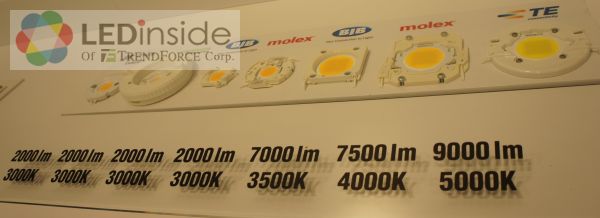At LightFair International 2012, which commenced on May 8-11 in Las Vegas, LEDinside conducted an interview with Mr. Jason Posselt, Vice President of Marketing at Bridgelux, shedding light on the latest development of LED lighting and GaN-on-Si technology.

Mass Production of 8-inch GaN-on-Si LEDs
Posselt said that Bridgelux has successfully developed a 135lm/W GaN-on-Si LED. The GaN-on-Si technology helps reduce the cost of turning a large-size wafer into a LED. Also, silicon substrate’s cost is lower than that of sapphire substrate. In the past, the technology garnered little attention due to its low yield rate and high cost and technology threshold. Now Bridgelux has successfully developed competitive products which are adopted by many clients.

Bridgelux’s cooperation with Japanese big name Toshiba generated a lot of attention. The two companies will manufacture 8-inch GaN-on-Si LEDs in a certain Toshiba plant in Asia. The production is set to kick off in 2H12 and bloom in 2013, aiming to reduce the manufacturing cost by 75%.
Posselt noted, however, the market prices will not actually see a 75% decrease overnight, but the LED price will surely continue dipping. The company focuses on the LED lighting market and has sought joint efforts with a number of LED module makers.
According to LEDinside’s survey, the previously-released GaN-on-Si LED’s efficacy is 135lm/W (350Ma, 1.5mm, color temperature 4730K) with very low forward voltage and good thermal dissipation, suitable for lighting applications.
As for Bridgelux’s new 8-inch GaN-on-Si LED, it has the highest efficacy among all the 8-inch GaN-on-Si LEDs (614mW, <3.1V@350mA, 1.1mm). The company said it will further its development in this regard.
Bridgelux and Toshiba stated that they will strive to increase GaN-on-Si LED’s market acceptance and make inroads into LED backlight and LED lighting markets. Additionally, they also cooperate with solid-state lighting companies in the hope of accelerating the commercialization of GaN-on-Si LEDs.


High Color Rendering Index Became the Norm
At LFI 2012, high color rendering index (CRI) was the feature able to be seen in most participating companies’ LED products, but the prices were not particularly consumer-friendly. LED products with a CRI of 90 are the norm now, and products with CRI above 90 are expected to become mainstream in the future.

LEDinside noticed Bridgelux has also improved its products in terms of CRI, which are well-received in the commercial lighting market. Posselt stated that the company used different phosphor powders to achieve high CRI.

With respect to Bridgelux and RD Leuchten AG’s LED project for Swiss department store chain Manor AG, 2,4000 LED lights were used in 25 stores with space of 57000 square meters. It reduces the CO2 emission by 1200 tons and saves US$500,000 electricity and maintenance cost per year.


In terms of CRI, R9 can reach 98 with the average of other products above 97.
New LED Modules Support Different Specifications
Posselt pointed out that Bridgelux’s new Cetero module meets Zhaga standard, and the company’s LED modules have been adopted by many LED firms for different specifications, such as the United States’ Molex and German’s BJB.

Perspectives from LEDinside
The rise of GaN-on-Si technology is expected to make a large impact on the LED industry which is currently dominated by sapphire substrate technology. 2013 will see a fierce competition between old technology and new one. The LED lighting market is soaring, and LED penetration rate is climbing in public lighting, commercial lighting and new lighting projects. If LED’s manufacturing cost can be further reduced, the LED penetration rate will see a sharp surge.





 CN
TW
EN
CN
TW
EN







